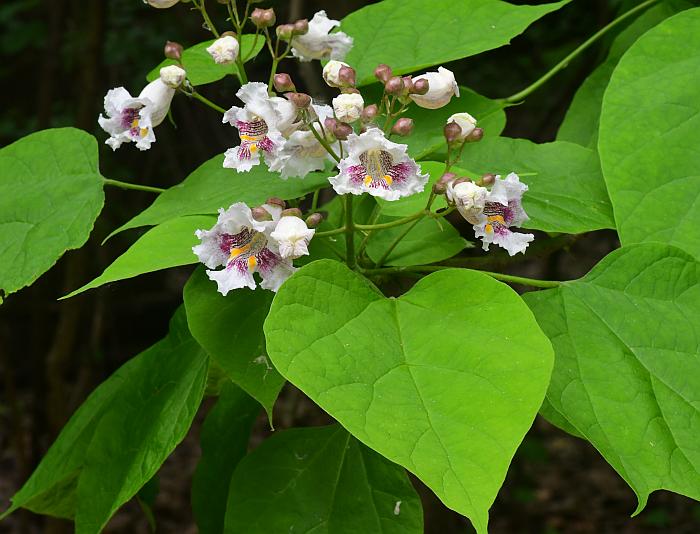Catalpa bignonioides Walter
Southern Catalpa

Introduced
CC = *
CW = 3
MOC = 15
© SRTurner
Catalpa bignonioides WalterSouthern Catalpa | |
 |
Introduced CC = * CW = 3 MOC = 15 |
© SRTurner |
|
Family - Bignoniaceae Habit - Tree, to 15 m tall. Stems - Woody, single trunk. Bark light brown, divided into thin, scaly plates on older trunks.
Leaves - Opposite or in whorls of 3, simple, long petiolate. Blades 8-22 cm long, ovate, entire or less commonly shallowly 3-lobed or 3-angled toward the base, narrowed or short-tapered at the tip, the bases truncate or cordate, the upper surface glabrous, the undersurface persistently pubescent with short, curly, unbranched to stellate hairs, especially along the veins.
Inflorescence - Terminal panicle to 20 cm tall.
Flowers - Calyces 2-lobed, 9-12 mm long. Corollas zygomorphic, glabrous, 5-lobed, 2.5-4.0 cm long, the middle lobe of the lower lip not notched. Corolla white externally, patterned with purple and yellow or orange stripes and markings internally. Stamens 2. Staminodes 3, minute, fused to the corolla tube.
Fruits - Elongate capsules 20-45 cm long, 0.6-1.0 cm in diameter, pendent, relatively thin-walled, the valves becoming flattened after dehiscence. Seeds with the body 12-16 mm long, 2.5-4.5 mm wide, the hairs of the tufts converging to a more or less pointed tip. Flowering - May - June. Habitat - Streambanks, roadsides, railroads, moist disturbed areas. Also cultivated. Origin - Native to small portion of the southeastern U.S. Lookalikes - Catalpa speciosa. Other info. - This species can be difficult to tell from its close sibling C. speciosa, but typically has smaller flowers and fruits than the latter. Also, the corollas of C. bignonioides have a denser pattern of lines and spots in the throat, and the leaves have a strong unpleasant odor when crushed or bruised, whereas those of C. speciosa are less strongly and more pleasantly scented. Also, the lower flower petal in C. speciosa is broadly and shallowly notched, whereas the lower petal in C. bignonioides lacks this feature. Some botanists consider the two taxa synonymous. Photographs taken at Riverfront Park, Washington, Franklin County, MO, 5-28-2020 (SRTurner). |